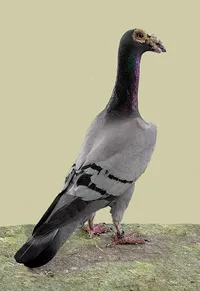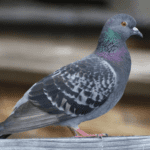The homing pigeon, aka the Columba livia f. Domestica, is prized for its superior navigational abilities. Racing pigeons are specially trained homing pigeons also used in racing shows.
| Breed name | Homing Pigeon |
| Scientific name | Columba livia f. Domestica |
| Other names | Mail pigeon; Messenger pigeon |
| Breed class | Vary |
| Special features | Hardy, active, excellent flying capacity, beautiful. |
| Flying ability | Excellent |
| Special skills | Navigational abilities; long-distance communication, and athletic skills |
| Purpose | Used as messenger pigeons during wartime (WW1 &WW2) Currently varies depending on the pigeons’ varieties |
| Colors | Vary depending on the pigeon variety |
| Size | 11-14 inches |
| Can be kept as pets | Yes |
| Origin of the fastest racing pigeon breed | Varies |
| Distance coverage | 1000 km (Approx.) |
| Average speed | 60 mph |
| Average lifespan | In the wild: Up to 5 years In captivity: Up to 15 years |
The basic characteristics of homing pigeons are listed in the table above.
What is a homing pigeon?
Homing pigeons are a common type of pigeon. They are residential pigeons that were once used for message delivery.
The Homing pigeon is a domestic pigeon with an innate ability to home. The wild rock dove is the ancestor of these pigeons. Homing pigeons are prized for their ability to return home from great distances and at high speeds. Homing pigeons are bred specifically to be trained for pigeon racing competitions.

Andreas Trepte (CC BY-SA 2.5) from Wikimedia
Homing pigeons that have been specially bred to be trained for pigeon race shows can fly at a breathtaking 60 mph and cover more than 1000 km/h. What’s more, these pigeons were used to carry messages during the Great War, but they are not carrier pigeons.
Homing pigeon types
Homing pigeons are domestic pigeons that come in two varieties: homers and racers. While regular pigeons are homers, racing pigeons are homers that have been specially trained for pigeon racing shows.
How to identify homing pigeons?
All pigeons may appear the same to a novice. However, certain traits set apart various pigeon species. So let’s examine the homing pigeons’ distinctive qualities.
The following characteristics of homing pigeons will help you recognize them.
- A body that is round and thin
- Round and erect head, which is in proportion to the body
- Broad chest
- Iridescent collar coat
- A thin and short neck
- Different coat hues depending on the type
- Different eye colors, including gray, brown, orange, yellow, and red
In addition to their physical characteristics, homing pigeons frequently have bands attached to their legs. The numbers on this band can be used to find the owner.
How do homing pigeons find their way home?
Homing pigeons are renowned for their unusual ability to navigate back to their nest. But how they accomplish it? Check it out.
Pigeons primarily use magnetoreception to find their way through the air. Experts aren’t entirely sure how these birds use this mechanism, though. According to recent research, scientists have proposed two theories: the use of magnetic material inside them and a “free-radical pair” based on vision.
In addition to these hypotheses, researchers are currently studying “cuticulosomes,” iron particles found in pigeon ears. They are investigating whether pigeons’ iron cuticulosomes can function as magnetoreceptors. However, drawing any specific, constructive conclusions is still only a distant dream.
Top incredible facts about homing pigeons you may not know

Below are some fascinating facts about homing pigeons.
- They have an uncanny sense of direction.
- They can travel hundreds, if not thousands, of miles to return home.
- Racing homing pigeons is a legitimate and popular sport.
- Homing pigeons can fly long distances fast.
- Homing pigeons trained for racing can even reach speeds of up to 90 miles per hour (average)
- Racing homers have also been known to fly 700 miles home in one day.
- Homers served as messenger pigeons in both World Wars.
- Homing pigeons were used as messengers in ancient times as well. We can find such records during the time of Julius Ceaser, Napoleon Bonaparte, as well as Genghis Khan.
- Racing pigeons with a good pedigree can sell for as much as $400,000 USD.
- Bolt, a racing home, was purchased for 310,000 euros.
- Both parents are concerned about their children. Males incubate the eggs during the day, while females do so at night.
- To feed their children, both parents produce a milk-like substance.
- Racing homers can see for well over 26 miles.
How to feed homing pigeons?
It is a wrong notion that all birds need grains to feed on. Instead, different birds need different foods, grains being one of them. So, let’s shed light on what and how to feed homing pigeons.
Pigeon diets have a balanced mixture of seeds and grains and can be fed to homing or domestic pigeons. In addition, there are various diet formulations available for breeding, resting, and performance. That said, if your homer pigeon is getting trained for racing sports, including protein (12–14%), fat (7–15%), and carb in its diet.
You can feed your homing pigeons the following additional foods as well.
- Pelletized Food
- Veggies and fruits
- Moderate to minimal dairy consumption (birds are typically lactose intolerant)
Here, you should remember not to give your pigeon junk food, salty foods, chocolates, or beverages with caffeine or alcohol. These foods may be poisonous to birds.
How to train a homing pigeon?
Training homing pigeons has always been crucial. Initially, homing pigeons were trained to carry messages and are now used in pigeon racing competitions.
Here, we’ll learn more about the homing pigeon training procedure.
Start early
Always start training your homing pigeon when it is at least 6 weeks old. The pigeons can be trained at this age to find the trapdoor in the loft and return home after being released.
Do not take them too far
Please don’t take them too far away from their loft while releasing them all at once. Also, keep in mind that training homing pigeons takes time and effort. Therefore, take it slowly but steadily.
Set the base location well
Training the homing pigeon to fly between two locations is the main objective. Thus, you must first establish their home loft as the base location. It ought to have a trap door that lets them into the loft but keeps them from leaving. Set the alternate location apart from the base loft. And eventually, the distance between these two bases needs to be widened.
Make adequate facilities
Make the pigeons’ base and alternative loft comfortable. They should be equipped with everything they need to make them want to go back to their starting point. The presence of water, enough food, and protection from predators, among other things, will entice your pigeons to return to their loft.
Proper timing and distance
With time, the flying distance between the two locations ought to grow. Or, to put it another way, you should subsequently extend the releasing distance. For example, you could extend the flying distance between two points by roughly 5 miles per week.
It will also be beneficial to release the birds after taking them in multiple directions. Additionally, keep a close eye on the birds if they appear distressed or have a propensity to wander off. In these situations, keep working them out at the distance where they last had success.
Prevent loosing birds
Watch out for bird loss. Although losing birds is saddening, it happens frequently. However, some pigeons might merely become exhausted on the return flight and require some downtime. So, be patient and persistent for your bird to come back for a few days. If you notice a lot of bird losses, potentially reduce the training sessions on distance and time.
How to breed homing pigeons?
Pigeons are usually bred during the winter months. However, the process is too challenging and needs to be handled with utmost care and conviction.
Here are some top steps you can take to ensure that your pigeon pairs are in a good mood and condition to give birth to their young.
- Verify the pigeons’ well-being. If necessary, start consulting the vet in late October or early November.
- For the breeding pair’s comfort, the loft should be kept tidy.
- Start feeding a special breeding mixture to the pigeons that will be bred.
- Speak with a veterinarian to find out more about how to start feeding your pigeons the breeding mixture.
- Pre-coupling the breeding pair can be fruitful to let the pigeons stay with each other and get customized.
- To give the breeding pigeons some privacy and time to rest, keep them away from curious eyes. Prior to laying, it is best to leave the pair in their nest box for a few days.
Homing pigeon vs carrier pigeon

jim gifford (CC BY-SA 2.0) from Wikimedia
Despite being used as message carriers, homing and carrier pigeons are not the same. Career pigeons are an old breed of fancy pigeons, whereas homing pigeons are domestic pigeons.
Here is a table listing the characteristics that set homing pigeons apart from carrier pigeons.
| Attributes/ Characteristics | Homing Pigeons | Carrier Pigeons |
| Breed name | Homing | Carrier |
| Breed class | Vary | Large |
| Purpose | Can vary depending on the type | Flying, show, pets |
| Country of origin | Vary | The UK |
| Climate tolerance | Typically all | Usually native climate |
| Body features | Slim and slender Short and stout neck Iridescent neck color Wide chest | Long and slender Long neck Rounded hard wattle |
| Coat color | Vary | Mainly dark |
Currently, carrier pigeons are strictly used as show or pet pigeons. However, because contemporary homing or racing pigeons are partially descended from the English Carrier, they are incorrectly referred to as “carrier pigeons.”
Summary
With this, we come to the end of our post on the different characteristics of homing pigeons. To round everything up, we want to highlight that homing and racing pigeons are the same. As a result, there are many similarities between the two. And if you wish to read about racing homers or racing pigeons, please refer here.




